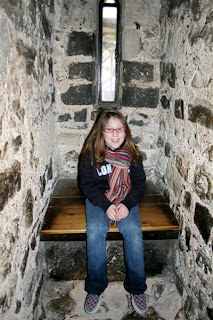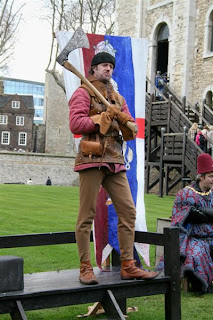








 Fo
Fo
One of the most popular Tower attractions involves people: the Yeoman Warders to be exact. They were originally established in 1485 as King Henry VIII's bodyguard. They are perhaps best known for their gorgeous scarlet and gold dress uniforms which date to 1552 and are worn on state occasions. They are usually seen at the Tower in the blue undress uniform granted to them by Queen Victoria in 1858.
The Yeomen Warders, also known as the Beefeaters, are armed with a haberd or pike known as a partisan. The Chief Warder carries a staff surmounted by a silver model of the White Tower, while his second-in-command, the Yeoman Gaoler, possesses a ceremonial axe.
The popular name Beefeaters may have been derived from their fondness for roast beef; however, it has also been suggested that it comes from the French buffetier. Moreover, the term may originally have been derogatory, used by the lower classes in sneering at the "pampered guards" who regularly ate beef, while they rarely had any.
There have always been ravens at the Tower of London, and some are usually seen strutting about Tower Green. They are unfriendly and we were told not to touch or feed them. Their wings are clipped so that they cannot fly away. A curious superstition dating from the time of Charles II It was prophesied that when there are no longer ravens in the Tower both the White Tower and the British Commonwealth will fall.
Traitors Gate was originally known as Water Gate, but was later changed when it was used as the landing for the Crown's enemies. All important prisoners entered the Tower through this gate. According to legend when Princess Elizabeth arrived on Palm Sunday 1554 she refused at first to land at the gate, angrily proclaiming that she was no traitor. A sharp shower of rain however, caused her to change her mind. Later when as Queen she visited the Tower she insisted on passing through Traitors Gate. "What was good enough for Elizabeth the Princess is good enough for Elizabeth the Queen", she is supposed to have told the Constable.
In the White Tower the medieval kings of England lived with their families and their court. Here was the seat of government and here the laws of the land were made. The royal family lived in the top storey; the council chamber was on the floor below. In this chamber in 1399 Richard II was forced to sign away his throne, and in 1483 Richard III summarily sentenced Lord Hastings to death. The White Tower and the New Armories now contain the national collection of arms and armor. As the most important fortress in the kingdom, the Tower must have held armor and arms from the time it was first built, but in their present form the Armories date from the time of Henry VIII. The collection -- one of the greatest in the world -- illustrates the development of arms and armor from the Middle Ages to 1914.
The White Tower is entered through the Tournament Room. The display here is devoted entirely to armor specially designed for use in warlike exercise. This collection includes the tilt armor for the German form of joust known as the Scharfrennen, in which sharp lances were used, and the splendid Brocas helm. The armor was made about 1490 in Germany for use at the court of Emperor Maximillian I; the tilt helm was probably made in England in the same period.
In tournaments mounted men ran different courses against each other, each course requiring armor of a special design. Men also fought against one another on foot and this required amour of yet another pattern. The Armories contain three foot-combat armors made for Henry VIII; the first dates to about 1512 and the second about 1515 when he was slim and active. The third one was made in 1540 when he was forty-nine and very portly. The middle armor is remarkable in that all the plates fit together, over flanges, thus enabling his height of six-feet one-inch to be accurately determined.
In the adjacent room the collection of hunting and sporting arms includes crossbows and firearms. Here can be traced the technical advances in firearm mechanisms, from the match lock, the snaphance and the wheel lock to the flintlock. The development of decorative techniques is also evident. Craftsmen applied or inlaid precious metals, ivory, bone and even mother-of-pearl to enhance the wood they carved and chiseled with such consummate skill; the contemporary artistic styles from the 15th to the 19th centuries can thus be compared.
The Crown Jewels are what most visitors to the Tower of London come to see. This incomparable collection of crowns, orbs, swords, scepters and other regalia, and gold and silver plate was refashioned in 1661 after parliament had ordered the original gold and precious metals to be melted down for coinage in 1649.
The Imperial State Crown worn by monarchs at their coronations is set with jewels of great antiquity and historical significance. The oldest is Edward the Confessor's sapphire, believed to have been worn by him in a ring and now mounted in the cross patee above the monde. The great gem above the rim is the ancient balas-ruby, known as the Black Prince's ruby, which is said to have been given to him by Pedro the Cruel of Castile.
From the intersections of the arches hang four superb drop pearls, the so-called Queen Elizabeth's Ear-rings, but there is no evidence that she ever wore them in this way. Set in the rim at the back of the crown is the Stuart sapphire. It is probably much older than its name implies, but is known to have been in the possession of James II when he fled to France after his deposition. It was formerly mounted in the rim, at the front, but was displaced by the Second Star of Africa cut from the Cullinan diamond. In addition to these jewels, the Imperial State Crown contains over 3,000 diamonds and pearls, as well as fine sapphires, emeralds, and rubies.



























No comments:
Post a Comment